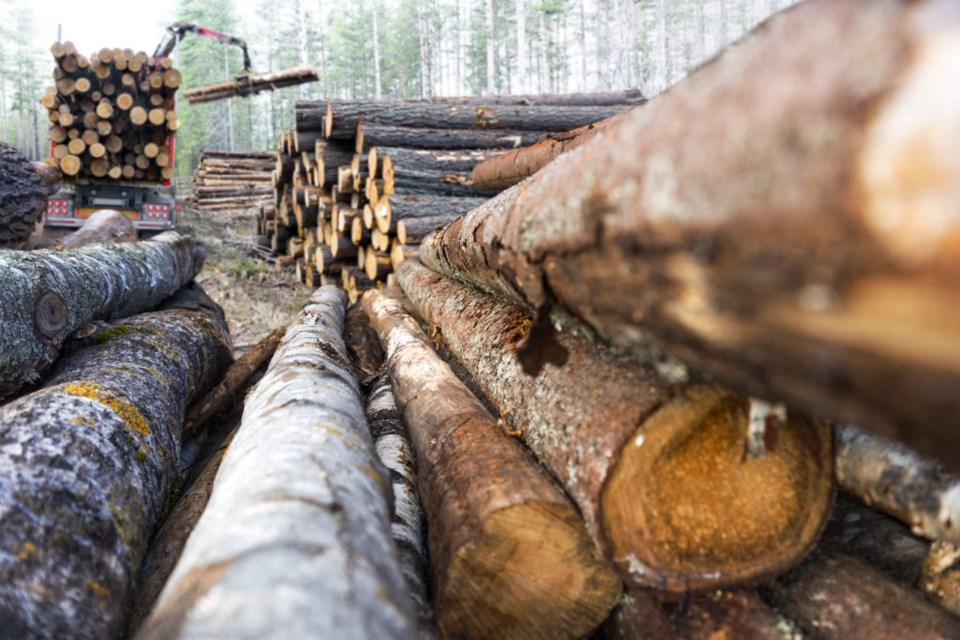Scott Hayes | [email protected]
Local Journalism Initiative Reporter
Industrial logging is one of the country's biggest climate polluters with more than 10 per cent of CanadaÔÇÖs total planet-heating emissions.
This is according to an analysis of the produced by both Nature Canada and the Natural Resources Defense Council (NRDC), an American environmental advocacy group.
In 2021, the amount of carbon dioxide that logging produced came in at 73 million tonnes, the equivalent of the annual greenhouse gas (GHG) emissions of more than 22 million gas powered vehicles.
Nature Canada to demonstrate these findings. At the same time, it expressed its concern over the federal governmentÔÇÖs failure to both clearly report logging emissions and also to admit and work to reduce these emission levels from the logging industry.
Michael Polanyi, policy and campaign manager at Nature Canada, explained that the federal government reported emissions from both harvested wood products and forest lands as a net flux from forest land and the emissions associated with wood thatÔÇÖs harvested for it.
ÔÇťThe number they come up with is close to zero,ÔÇŁ he said.
ÔÇťThey recognize there's a mass of emissions associated with removing wood from forests, but they claim credit for a large amount of regrowth of carbon sequestration in forests that are not logged or planted. There's a problem which the Environment Commissioner wrote a report about recently that the government is not telling the Canadian public what are the net greenhouse gas emissions that the logging sector is responsible for.ÔÇŁ
Using the data from the governmentÔÇÖs own report for its own calculations, Nature Canada took the reported amount of carbon removed from forests each year and subtracted both the amount of carbon that is added to long-lived wood products (i.e. 2x4s, building materials, etc.) and the net carbon flux from re-growth after logging, which refers to how companies plant saplings that grow into trees that suck carbon out of the atmosphere.
The figure of 73 million tons of carbon dioxide equivalent is slightly down from what the number equals the emissions from logging were in 2020, which was 75 million tonnes. The long-term trend shows a reduction in net emissions from logging, mainly due to a decrease in the total area being logged.
The joint analysis came two weeks after a federal audit that criticized the Trudeau government for neglecting to transparently report logging emissions in its National Inventory and 2030 Emissions Reduction Plan.
ÔÇťIgnoring GHG emissions from logging is akin to ignoring all the emissions from the province of Quebec. Without addressing them, CanadaÔÇÖs climate plan is half-baked, and its forest policy grounded in specious narratives that mask the real cost of the widespread clear-cutting of primary forests,ÔÇŁ said Jennifer Skene, natural climate solutions policy manager at the NRDC.
ÔÇťI think everyone agrees that good policymaking when it comes to reducing emissions depends on an accurate and transparent reporting of greenhouse gas emissions from all sectors of the economy. It's a problem,ÔÇŁ Polanyi said.
Polanyi added that their work indicates that the net climate impact of industrial logging was significant.
ÔÇťLogging is one of the major emitting sectors in the Canadian economy,ÔÇŁ he said.
ÔÇťThe government needs to acknowledge that and put in place effective policies to encourage the transition of the sector to lower carbon approaches to forestry not only to protect our climate, and not only to better protect the biodiversity that is dependent on Canada's boreal forest and old growth forest, but also to support an industry that's going to be competitive in a marketplace globally that is increasingly demanding products, which are produced in a sustainable way.ÔÇŁ
James Gorman, West FraserÔÇÖs senior vice president of corporate government relations, confirmed his companyÔÇÖs commitment to being a responsible steward of the environment, a task that he said also serves to protect the health and safety of its employees and the public at large.
Globally accepted standards are still being developed for how to calculate carbon on the land, particularly important for forestry and agriculture. Earlier this year, West Fraser became one of the first Canadian companies to have its science-based GHG emissions reduction targets validated by the Science Based Targets Initiative (SBTi).
ÔÇťThis will see us reduce direct emissions that are controlled by West Fraser (scope 1 emissions) such as combustion from company-owned equipment as well as the indirect emission from the energy we purchase (scope 2) by 46.2 per cent by 2030,ÔÇŁ Gorman said.
ÔÇťWe are also validated to reduce other indirect emissions in our supply change (scope 3) by 25 per cent by 2030.ÔÇŁ
West Fraser is now in a good position to ÔÇťmaterially reduce GHGsÔÇŁ in alignment with the Paris Agreement goals by 2030. The Hinton Mill is in the initial months of its transition to single-line unbleached Kraft pulp, a sign of a growing global demand for more environmentally-friendly products. Such a shift eliminates bleaching chemicals like chlorine dioxide from its processes.
Water use at the mill has also decreased by approximately 23 per cent. Reductions in waste generation and greenhouse gas emissions are other anticipated environmental benefits.




